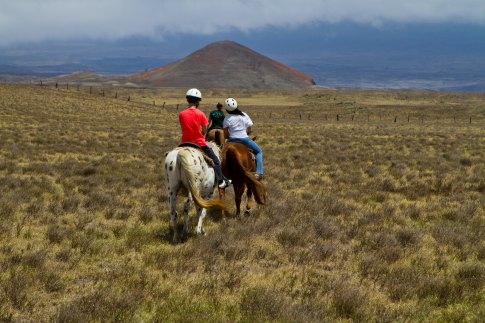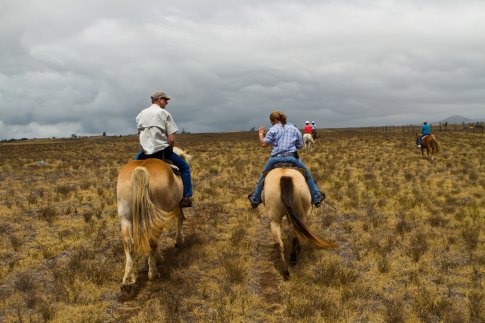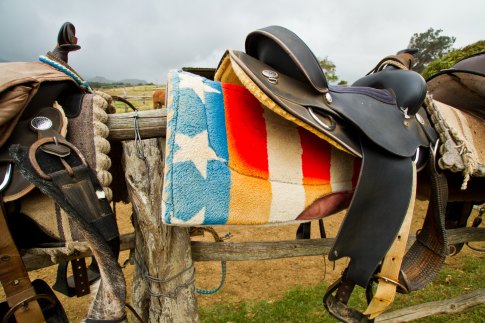I had not been on a horse in awhile. The last time was probably four or five years ago and it was at my sister’s “ranch” in upstate New York, when they loaded me up on a cranky horse who threw me off within the half hour. I’m not really a rider although my sister and niece are more passionate about horses than life itself.
When you are part of a family who live and breathe everything horses, of course you want to learn more about them and even learn how to ride “seriously,” yet the time and financial commitment has never been there especially given the umpteen other passions I have in my life.
Frankly, I get the horse thing…maybe not 24/7, but I get it. They’re beautiful beautiful animals, with as much mystery and power as grace and style. I have a cousin who is a part owner of a racehorse in Saratoga Springs New York and an aunt and uncle who used to drag me to the Saratoga track as a child every August. Horses are not new to me, but it never got in my blood as they say.
When offered a chance to ride on not just a beautiful property in Hawaii, but one of the largest ranches in the United States, how could I not be a l’il excited? One of these days, perhaps I’ll learn to ‘ride a stallion like a pro’ so I’m not thrown off and an embarrassment to my horse loving & riding family.
Alas, an introduction. Meet Cowboys of Hawaii, which offers rides in the vastness of Parker Ranch on the Big Island of Hawaii.
And so, I headed towards Parker Ranch for my Hawaiian “western ride”. Lost as always (this is even the case with a GPS which I didn’t have with my rental), I called the number I had on hand. “Just head south from the main drag,” she said, “and you’ll find us.”
Someone like me needs a whole lot more direction than that…her voice and tone reminded me of family and friends in my home town – they don’t mention the route number, know the local landmarks and road ‘names’ and don’t have a whole lotta time for out of towner “how do I get there questions.” As I got close, she said, “are you driving a yellow Camaro?” “Yup,” I replied. “You’re here,” she said and put down the phone.
“Where the hell is here?” I thought since I knew I hadn’t ‘arrived’ yet but I also figured that driving a bright yellow Camaro convertible lost me some brownie points with she and her ‘tribe.’ Little did they know that I had been upgraded to the flashiest, brightest looking thing on the lot by accident. It may as well have been bright pink and I may have well been carrying a furry purse but I wasn’t – I was in shorts, had a backpack and most definitely wasn’t used to my albeit cool flashy Camaro convertible.
Soon after rubber met the soil, I met Sarah Chow (above left and right), who was there by accident that day since the woman I was supposed to meet for my ‘ride’ was named “Tootsie”. Yes, really. Sarah had a family funeral earlier that morning and yet still showed up for work along with her younger sister who just graduated from high school. (talk about commitment). These girls love to ride and they love ‘horse life’ which means something to those who live and breathe it. 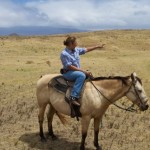
They were also working “Parker Ranch”, which is among the largest ranches in the United States, spanning thousands of acres across Hawaii’s Big Island. It is one of the country’s oldest ranches, with more than 160 years of history and “Home of the PANIOLO.”
There’s a long and interesting history behind the ranch which begans in 1809, a generation after Captain James Cook first encountered these tropic isles.
A nineteen year old sailor named John Parker jumps ship and hides in a thicket as the ship that brought him to Hawaii drops below the horizon. John Parker comes to the attention of the great King Kamehameha I, the monarch who fought to unite the islands in a single kingdom, and John is given important tasks by the king. John returns one more time to the sea for adventure in China during the War of 1812, but then returns to Hawaii to stay for good.

Having brought back with him a new, state-of-the-art American musket, John is given the privilege of being the first man allowed to shoot some of the thousands of maverick cattle that roam Hawaii’s remote plains and valleys. These rangy beasts are the legacy of British Captain George Vancouver, who presented Kamehameha with five head just 21 years earlier.
Due mostly to John’s efforts, salt beef eventually replaces the increasingly scarce sandalwood as the island’s chief export. As the need for beef increases, so does John’s fortune and influence. A year after he returned to Hawaii in 1815, he married Kipikane, the daughter of a high-ranking chief, who took the Christian name Rachel. Rachel Parker bears John a daughter and two sons, and the Parker dynasty begins, figuring prominently in the next two centuries of Hawaiian history.
As the Parker family fortune grew, the highlands of Waimea become a bustling center of trade. The family grew too and over the years, the Ranch ventured into areas outside cattle ranching. In 1887, they searched for a good, strong manager, resulting in Alfred Wellington Carter, a respected Honolulu businessman and judge, who became Parker Ranch’s champion, who ended up guiding its growth for nearly half a century.
Between 1942 and 1945, Waimea was home for 50,000 Marines from the Second and Fifth Marine Divisions and the V Amphibious Corps as they prepared for the battles of Iwo Jima and Okinawa. Apparently, Parker Ranch played an integral part in hosting the Marines at what became known as Camp Tarawa.
In 1992, following the death of sixth generation Parker descendant Richard Smart, the ranch’s last owner, Parker Ranch, complete with Smart’s extensive art collection was left in a trust to support healthcare, education and charitable giving through named beneficiaries in the Waimea community. The Parker Ranch Foundation Trust beneficiaries include Parker School Trust Corporation, Hawaii Preparatory Academy, Hawaii Community Foundation’s Richard Smart Fund and North Hawaii Community Hospital.
And so, “it’s no longer a ‘family owned farm’ but a trust-owned farm,” says Sarah.
I found myself more interested in Sarah’s story given her passion for the land, horses and ranching. Isn’t it always about a personal connection, a l’il history and great storytelling?
Years later, there are no longer any Parkers involved with the ranch. Today Parker Ranch sits on about 135,000 acres, with nearly 20,000 head of cattle including mother cows, calves, finishing steers and bulls. The ranch is very much still a working cattle operation, promoting a local beef market throughout the United States and it remains expansive and abundant with trees, birds, and fauna in all its natural beauty. I certainly felt that on my ride.
Sarah is a born storyteller. She talked about ranching and ‘cowboys’ and how she was born to be both a rancher and a cowboy. With a big bright smile she said, “I am a cowboy and rancher and will marry one.”
“Really,” I replied almost immediately. “How do you know you’ll FALL IN LOVE with a rancher?” “It’s in my blood and what I know I’ll do,” she said. Crikey, talk about congruency and alignment. How many 21 year olds can be that certain about their destiny and state it with such conviction?
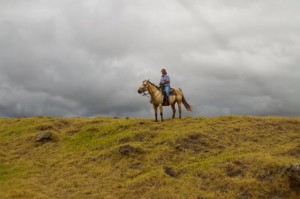 She was born and raised on the big island in the district of Ka’u, Kapapala Ranch. Kapapala, which rest on the slopes of Mauna Loa, is also a working cattle ranch running on a little over 30,000 acres. She grew up with no main streets and no traffic lights on the outskirts of a town with only about 600 people.
She was born and raised on the big island in the district of Ka’u, Kapapala Ranch. Kapapala, which rest on the slopes of Mauna Loa, is also a working cattle ranch running on a little over 30,000 acres. She grew up with no main streets and no traffic lights on the outskirts of a town with only about 600 people.
Sarah has been on the back of a horse since infancy. It was her parent’s idea to have all their children riding before they could walk. Her dad said it was a good way to build character. (sounds like my grandfather Sarah – perhaps they should have met).
Their ranch was their backyard. As a child she rode for fun and as a teen she rode for work. Says Sarah, “ranch riding is what I was accustomed to.
Saddle up for the weekend of cattle drives and corral work.” She added, “as for a trail guide you could says it runs in my maternal blood. My mother was a trail guide on the island of Moloka’i , though instead of horses she worked with mules. She lead the rides down the Kalaupapa switch back cliffs.”
She says of her father, “it was his dream to raise his family working what he calls a honest life — Cowboy Life, with pleasures also come pain. Ranching put him through every physical test he could imagine, as well as mental. When dealing with animals, you learn how to think for them…knowing how and when to act and not react.”
Isn’t this a great message for life?
Ranching is a part of Sarah’s heritage. She is a 5th generation cowboy.(HOW COOL IS THAT?). Her great-grandfather was the first Chinese man to start ranching in Hawai’i. (HOW COOL IS THAT?) He paved the way into this way of life for her family and started a legacy that Sarah and her siblings have become proud of. 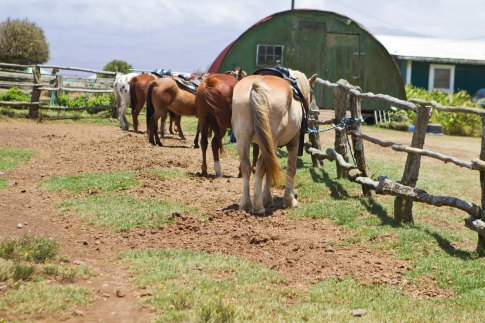
“I live a lifestyle that has taught me how to endure hard work and appreciate the reward,” says Sarah.
“This way of life teaches us responsibility, humility, patience and passion, for if you’re not passionate about what you do in life how can you gain respect for anything?
Hear hear Sarah. I couldn’t have set it better.
“Cowboy life will always be a part of me,” she adds. And, after my ride, I felt that in a very short period of time, she made cowboy life part of me.
So, while I was there for a so called western ride through Parker Ranch, I got so much more. I heard Sarah’s stories and learned about her heritage which is an extension of what Parker Ranch is about: ranching and the land. Her passion for this life is the conviction that John Parker would want to hear no doubt and the reason he put the ranch into a trust. (am speculating history as there will likely be 20 variations and stories of why he did so).
My point is that the cowboy’s heroes and heroines should prevail since it ‘ain’t an easy life.’ They live for the land, for the horses and for the ranching and cowboy lifestyle.
A cool and interesting tidbit you wouldn’t expect: the grass that the animals graze is called kikuyu, which is imported from South Africa.
It was a windy day and I felt as if we were being thrashed around and yet Sarah said, “it’s not that windy today,” so I only imagined that wind on the ranch was something they not only dealt with, but had to plan for regularly. Sarah rode a horse named Kalua who she said was way too good for the horse I was riding: Chino. I agree. My horse was slow and lazy. ”
“Who would she be a mate for I asked?” “Maybe Jake,” she said, who was a beautiful spotted horse I had my eye on before we saddled up.
A beginner rode Gypsy, a name I love and then there was P.J. and Alley. (I have to admit I love knowing the names of things, whether its of horses, dogs and cats, or cars, teddy bears and plants). I name them all. If I owned a horse, I’d probably even name the saddle.
Albeit windy, it didn’t detract from the vastness and beauty of the land.
If you find yourself in Hawaii and have an opportunity to go on a ride at Parker Ranch, go with an intention to feel the earth, feel the story and get connected to what was there before and what is there now. Lots of wind or no wind, the experience will open you up to a heritage, a deep one, even if not your own. Even the horses are designed for trail rides and that is what they’ve been trained to do, learn a bit about the beautiful creature you’re riding since they may have another passion just as we all have our own deeper inner passions that sit outside of what we do for a living. It is in this silence and listening that you’ll experience Parker Ranch with different eyes.
Below my horse Chino. (it’s amazing what it took to get this guy going yet perhaps his story and passion is yet to be told and he’s dragging his feet because of it – I get that). A l’il more time , a l’il more love, a l’il more passion, a l’il more heart, a l’il more Chino in his Chino perhaps?
For more posts on Hawaii, check out this section. To experience nature, botanical gardens and rainforest by segway, check out this post. For photos on the Hawaii Volcanoes National Park. For more on Hawaii and food/wine only, go here. For Hawaii and lodging, here. For more on Hawaii and arts, go here.

Renee Blodgett is the founder of We Blog the World. The site combines the magic of an online culture and travel magazine with a global blog network and has contributors from every continent in the world. Having lived in 10 countries and explored nearly 80, she is an avid traveler, and a lover, observer and participant in cultural diversity.
She is also the CEO and founder of Magic Sauce Media, a new media services consultancy focused on viral marketing, social media, branding, events and PR. For over 20 years, she has helped companies from 12 countries get traction in the market. Known for her global and organic approach to product and corporate launches, Renee practices what she pitches and as an active user of social media, she helps clients navigate digital waters from around the world. Renee has been blogging for over 16 years and regularly writes on her personal blog Down the Avenue, Huffington Post, BlogHer, We Blog the World and other sites. She was ranked #12 Social Media Influencer by Forbes Magazine and is listed as a new media influencer and game changer on various sites and books on the new media revolution. In 2013, she was listed as the 6th most influential woman in social media by Forbes Magazine on a Top 20 List.
Her passion for art, storytelling and photography led to the launch of Magic Sauce Photography, which is a visual extension of her writing, the result of which has led to producing six photo books: Galapagos Islands, London, South Africa, Rome, Urbanization and Ecuador.
Renee is also the co-founder of Traveling Geeks, an initiative that brings entrepreneurs, thought leaders, bloggers, creators, curators and influencers to other countries to share and learn from peers, governments, corporations, and the general public in order to educate, share, evaluate, and promote innovative technologies.


